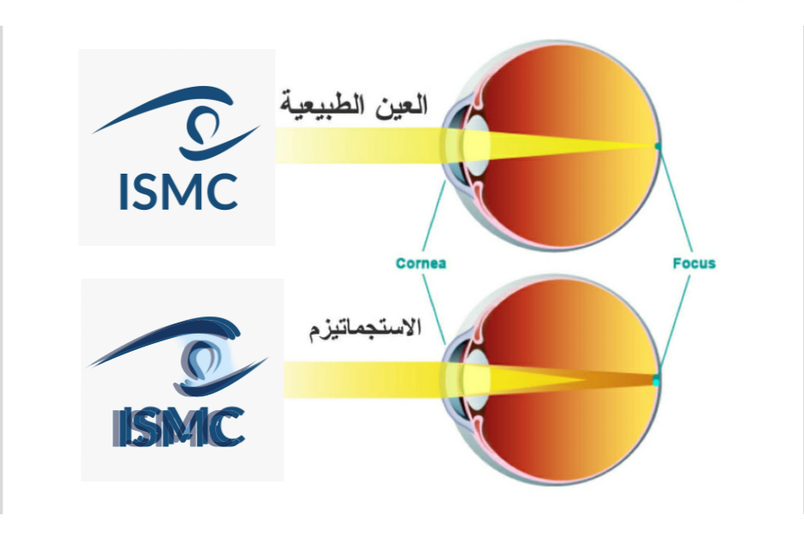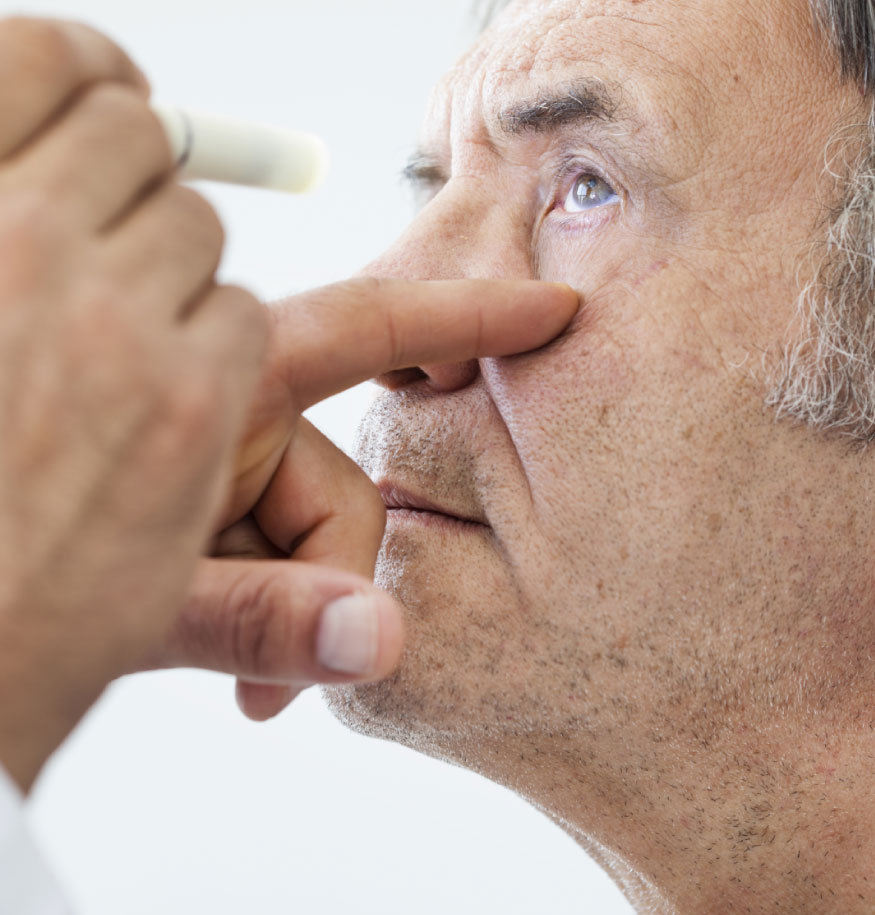- Patchy blind spots in your peripheral (side) or central vision, often in both eyes
- Tunnel vision in its later stages
But, in the case of acute angle-closure glaucoma, you will notice the below signs and symptoms:
- Severe headache
- Blurred vision
- Eye redness
- Eye pain
- Halos around lights
- Nausea and vomiting
Get medical care right away if you notice any of these signs or symptoms to prevent your condition from aggravating.
What are the Causes of Glaucoma?
Glaucoma is caused by optic nerve injury. As this nerve deteriorates, blind spots emerge in your vision field. For reasons that doctors do not completely understand, this nerve injury is frequently associated with increased ocular pressure.
An accumulation of a fluid (aqueous humour) that runs inside your eye causes elevated ocular pressure. This internal fluid usually drains through a tissue called the trabecular meshwork, which is located at the angle where the iris and cornea meet. When the solution is overproduced or the drainage mechanism fails, the fluid cannot flow out at its normal rate, creating increased ocular pressure.
Glaucoma is a disease that is passed on via families. Scientists have uncovered genes associated with excessive eye pressure and optic nerve injury in some people.
What are the Different Types of Glaucoma?
Glaucoma is divided into two categories. The majority, however, can be classified as either open-angle (chronic) glaucoma’s or angle-closure (closed-angle) glaucoma’s, which also comprise disorders that develop both abruptly (acute) and over a long period (chronic).
Secondary glaucoma is caused by another eye condition, trauma, or medicine, whereas primary glaucoma is not caused by another eye disease. Glaucoma usually affects both eyes, but the disease might advance more quickly in one than the other.
The following are the several forms of glaucoma:
When discussing the most frequent types of glaucoma, open-angle glaucoma is the first to come to mind. The drainage angle produced by the cornea and iris is clear, but the trabecular meshwork is somewhat clogged. As a result, the ocular pressure steadily rises. As a result of this pressure, the optic nerve is injured. It happens so slowly that you may lose sight of the problem before you know there is one.
Angle-closure glaucoma, also known as closed-angle glaucoma, develops when the iris bulges forward, narrowing or blocking the drainage angle formed by the cornea and iris. As a result, fluid cannot circulate in the eye, causing pressure to rise. Some persons have narrow drainage angles, making them vulnerable to angle-closure glaucoma.
When you have Norman-tension glaucoma, you have blind spots in your vision or your optic nerve becomes injured while having normal eye pressure. Some specialists believe it is a form of open-angle glaucoma.
Secondary glaucoma develops when another disorder, such as cataracts or diabetes, increases eye pressure.
In pigmentary glaucoma, pigment granules from your iris collect in your eye’s drainage ducts, delaying or stopping the fluid from escaping your eye. Jogging, for example, can stir up the pigment granules, depositing them on the trabecular meshwork and creating occasional pressure increases.
What Are Glaucoma Risk Factors?
When it comes to your eyes’ health, you must be careful. While you are looking for signs and symptoms of glaucoma, you should also be aware of the risk factors so that you can be better prepared. Because chronic glaucoma can ruin eyesight before any signs or symptoms occur, be aware of the risk factors listed below:
- Having high internal eye pressure (intraocular pressure)
- Being over the age of 60
- Being a black, Asian, or Hispanic person
- Having a glaucoma-related family history
- Having diabetes, heart disease, high blood pressure, or sickle cell anaemia
- Having thin-walled corneas in the centre
- Being either too nearsighted or farsighted
- Having suffered an eye injury or undergone certain types of eye surgery
- Long-term use of corticosteroid medications, particularly eyedrops
Consult an ophthalmologist about your risk of developing glaucoma. People who have more than one of these risk factors are at a higher risk of developing glaucoma.
What is the Diagnostic Process of Glaucoma?
A thorough eye examination is the only reliable approach to detect glaucoma. A glaucoma screening that solely measures ocular pressure is ineffective for detecting glaucoma.
Your ophthalmologist will do the following during a glaucoma exam:
- Check your eye pressure (tonometry)
- Examine the drainage angle of your eye.
- Check your optic nerve for damage.
- Examine your peripheral (side) vision.
- Take a photograph of your optic nerve or computer measurement of it
- Determining the thickness of your cornea
Glaucoma Treatments
The effects of glaucoma cannot be reversed. Treatment and regular examinations, on the other hand, can help decrease or prevent vision loss, especially if the disease is discovered early.
The treatment for glaucoma is to reduce your intraocular pressure (intraocular pressure). Prescription eye drops, oral drugs, laser treatment, surgery, or a combination of these may be available to you.
Medication
Eyedrop medicine is primarily used to treat glaucoma. When taken daily, these eye drops help to reduce ocular pressure. Some accomplish this by lowering the amount of aqueous fluid generated by the eye. Others alleviate eye pressure by increasing the flow of fluid through the drainage angle.
Any drug might cause side effects. Certain drugs can produce difficulties when used with others. You must supply your doctor with a list of all medications you take daily. Consult your ophthalmologist if you feel you are experiencing glaucoma medication side effects.
Laser Surgery
There are two forms of laser surgery for the treatment of glaucoma. They help with aqueous drainage from the eye. These treatments are usually carried out in the office of an ophthalmologist or an outpatient surgery clinic.
- Trabeculoplasty: This treatment is intended to treat patients with open-angle glaucoma. The eye surgeon uses a laser to adjust the drainage angle. As a result, fluid drains well and ocular pressure falls.
- Iridotomy: It is intended for those who have angle-closure glaucoma. A laser is used by the ophthalmologist to produce a tiny hole in the iris. This hole facilitates fluid flow to the drainage angle.
Operating Room Surgery
Some glaucoma procedures are carried out in a hospital operating room. It creates a new drainage route through which the aqueous humour can exit the eye.
- Trabeculectomy: It is the stage at which your ophthalmologist creates a little flap in the sclera. In addition, they will produce a filtration bleb, which is a bubble (akin to a pocket) in the conjunctiva. It is normally concealed beneath the top eyelid and is not visible. Through the flap, aqueous fluid will be allowed to drain from the eye and into the bleb. The fluid in the bleb is absorbed by the tissue surrounding your eye, decreasing your intraocular pressure.
- Glaucoma Drainage Devices: A small drainage tube may be implanted in your eye by the ophthalmologist. The glaucoma drainage implant directs the fluid to a collection place (called a reservoir). Your eye surgeon creates this reservoir beneath the conjunctiva.Your eye surgeon creates this reservoir beneath the conjunctiva. The fluid is then absorbed by neighbouring blood vessels.
- Cataract Removal Surgery:Removing the natural lens of the eye can help lower ocular pressure in some circumstances. It is most typically used on persons with narrow angles and high ocular pressure, glaucoma symptoms, or both.
Glaucoma Prevention
Glaucoma cannot be avoided. However, detecting it early can lower your chance of eye impairment. These methods may help to safeguard your vision, regulate high eye pressure, and promote eye health.
Examine your eyes regularly: The sooner your doctor detects glaucoma symptoms, the sooner treatment can begin. All adults should get their eyes tested for glaucoma every 3 to 5 years. If you are over 40 and have a family history of the condition, you should get a comprehensive eye exam performed by an eye doctor every 1 to 2 years. If you have diabetes or are at risk of other eye disorders, you should see your doctor more frequently.
Maintain a healthy diet: A nutritious diet can help you stay healthy, but it will not prevent your glaucoma from progressing. Several vitamins and nutrients are necessary for eye health, including zinc, copper, selenium, and the antioxidant vitamins C, E, and A.
Take the medication as directed: Using your eyedrops or other drugs exactly as prescribed can help you get the most out of your treatment. Make certain that you utilize the drops exactly as suggested. Otherwise, your optic nerve damage may increase.
Exercise in a safe manner:Regular exercise may assist persons with open-angle glaucoma to lower their eye pressure. Consult your doctor for advice on an appropriate workout routine.
Elevate your head while sleeping: It has been demonstrated that sleeping with a wedge cushion that elevates your head by roughly 20 degrees lowers intraocular pressure.
Conclusion
Glaucoma is a common eye disease that affects people as they age. It occurs when fluid does not drain from the eye, increasing pressure and the risk of optic nerve damage. In the early stages, there may be no symptoms, but it can lead to vision loss. Regular eye exams can aid in the detection of changes that will allow a person to begin treatment, usually with eye drops. This treatment has the potential to slow or stop the progression of the disease.
Remember only to reach out to the most advanced eye-care hospitals and clinics for your glaucoma problem if you have other health issues or even otherwise. our doctors at the international specialty medical center will guide you through the entire process. The doctors explain the risks involved and share their knowledge about glaucoma before and after your treatment. You can get in touch with the experts and get proper consultation by giving us a call at +971-4-344 11 42 or visit our website to fill out a form.










